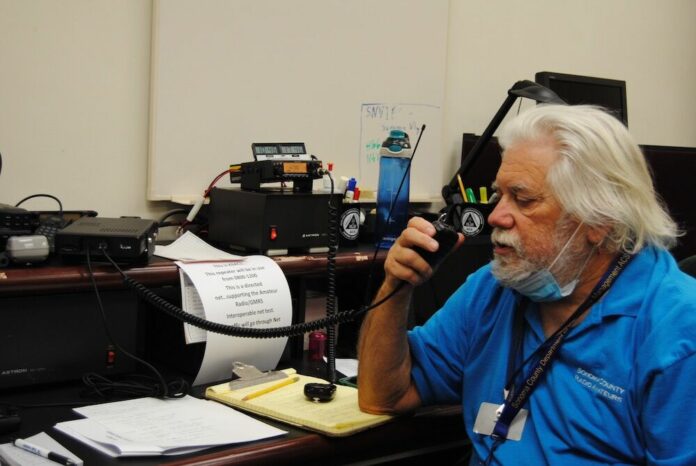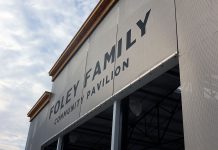“This is drill traffic. We have reports of a heart attack in the outlying area of Sebastopol — this is a drill, this is a drill,” a radio operator in Sebastopol relayed to Darryl Paule in a small office of the Sonoma County Department of Emergency Management in Santa Rosa.
“We want to know if there’s ambulance service available for the outlying area of Sebastopol. This is a drill,” the operator finished.
Paule took down an address for “Anywhere Road” in Sebastopol from the operator and closed out the message. “That was brilliant. That was absolutely brilliant,” he said to the others attending the emergency communications exercise.
On a Sunday morning in early June, Paule led neighborhood groups from the Russian River area to the coastal hills of west county in a drill testing how remote areas can get messages through to the county in a disaster that wipes out all other forms of communication.
Paule is the Auxiliary Communications Service (ACS) Unit Leader for the Russian River area, spanning Graton, Occidental, Guerneville, Forestville, Monte Rio, Cazadero and Duncans Mills.
ACS’ professional, unpaid volunteers aid the department of emergency management with the county’s emergency communications when disaster strikes, according to its county webpage.
Radio is what’s left when Wi-Fi and cell service are down, and the exercise explored how well combining the use of General Radio Mobile Service (GMRS) radio and amateur radio (ham radio) worked to get information and calls for help and supplies from neighborhood networks to the department in Santa Rosa and responses back.
Amateur radio has more capabilities than GMRS, according to Paule, but GMRS tends to be more accessible in that its licensing involves an application and paying a fee to the Federal Communications Commission, whereas amateur radio takes more intensive training to get licensed.
In the drill, various neighborhood associations and networks participating from Guernewood Park, Cazadero, Occidental, Sebastopol and other locations had a GMRS-licensed point person in the field who would initiate contact with a GMRS operator at their assigned fire station, Paule explained in an interview leading up to the June 6 event.
A GMRS operator and an amateur radio operator would be posted outside each fire station, Paule described. The GMRS operators received messages and passed them on to the amateur radio operator who then relayed to Paule, as net control, in Santa Rosa.
From there, the emergency communication — say, a need for water at a shelter — would hypothetically be imparted to the incident commander, Paule said.
That day, the incident commander was played by Sam Wallis, community alert and warning manager with the department of emergency management.
The incident commander would communicate with leaders of county departments assembled in a separate room in a major disaster to maximize communication and problem solving, according to county Transportation and Public Works Director Johannes J. Hoevertsz.
Hoevertsz attended the drill with enthusiasm, as did Sebastopol City Councilmember Diana Rich. The director said he was looking for where GMRS works and where it doesn’t work and that he plans to purchase radio repeaters where there’s an identified need.
He said he wanted to be able to communicate with people in the field, in CERT and COPE groups, to provide aid.
“Like, they can tell us where trees are down, where the bridges are failing right after an event where there’s no other way of communication. We can talk to the people down on the ground. This group could tell us this bridge is out, there’s a tree blocking the road, there’s a power pole blocking the road so we can get to help them,” he said, like cutting trees out of the way so people have an evacuation route.
A repeater can enable stations that are out of each other’s line of sight to exchange messages by receiving their signals and retransmitting or repeating them over farther distances, critical in places like west county with its uneven terrain.
Though a repeater losing function was included in the simulation for people to revert to using a different form of radio communication, a repeater actually did go down at one location before the drill even started. As if it were a real emergency, one individual went up to a higher elevation to act as a human repeater.
Lois Lebovich, president of the Guernewood Neighborhoods Association at the end of her term in June, participated in the drill.
“I became a ham radio operator in 2019 because, living out here in Guerneville with cell towers not working, PG&E shutting down our fire, evacuations from wildfires, it got to be kind of scary and I thought, there’s got to be a better way to communicate,” she said on June 27.
Lebovich said she started looking into GMRS radios online that her neighbors could use to stay in contact and escape the area in a potential disaster and informed Sonoma County Fire District Chief Mark Heine she was seeking funding for the radios in 2020.
According to Lebovich, the Guernewood Neighborhoods Association received a grant from SCFD that paid for radios and almost all of the FCC licenses for 34 residences. In the summer of 2020, she said, household by household came to her house and sat outside wearing masks where together they input information on her laptop to obtain the licensing.









